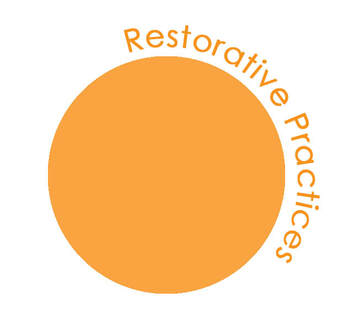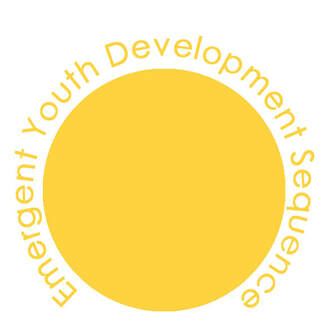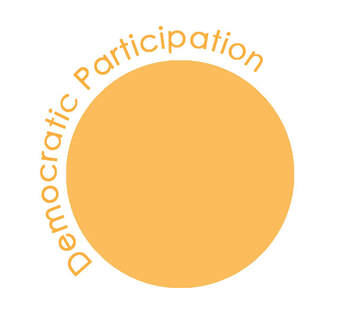Overview
“The goal is to create a beloved community and this will require a qualitative change in our souls as well as a quantitative change in our lives.”
— Rev. Dr. Martin Luther King, Jr.
— Rev. Dr. Martin Luther King, Jr.
Beloved Community as a concept grew from the soil of the American Civil Rights movement. Organizers like Ella Baker, who understood that social and political movements were by their nature about collective self-determination more so than singular charismatic leaders, focused efforts on building networks of beloved community through which people could both experience and create the kind of world they desired to live in. Vincent Harding (2014) describes beloved community as a process that includes, but also transcends, struggles against injustice, a process that builds networks of relationships in which people may experience “our best human development and our best communal development” (Tippett, para. 15). Grace Lee Boggs (2012) highlighted the notion that critical connections are more essential to movements than critical mass and urged contemporary social change movements to understand that meaningful shifts are “self-transforming and structure-transforming” (p. 39). bell hooks (1995) describes the way that love grounded the commitments through which black and white people struggled together for racial justice in the segregated South:
Understanding that love was the antithesis of the will to dominate and subjugate, we allowed that longing to know love, to love one another, to radicalize us politically. That love was not sentimental. It did not blind us to the reality that racism was deeply systemic and that only by realizing that love in concrete political actions that might involve sacrifice, even the surrender of one’s life, would white supremacy be fundamentally challenged. We knew the sweetness of beloved community. (p. 265)
Indeed, as hooks so aptly describes, there is incredible risk and struggle to be endured for those who dedicate themselves to transforming injustices, but there is also incredible sweetness in knowing and loving one another, and that love is the reason why the struggles are endurable. This consideration is not a sentimental abstraction that smooths over differences in order to create a false harmony, but a radical openness and commitment to eradicate the violence embedded in hegemony. Beloved community is both the outcome of struggle and the reason the struggle matters.
Sandra Cisneros (1989) explains, “We do this because the world we live in is a house on fire and the people we love are burning” (xviii). Truly, the beloved community we create in our classrooms is not an extra or frill, something to do on Friday afternoons when all the “real work” is done; rather, it is the singular most important aspect of our classroom life. Without relationships, connections, and a love for one another, there is no foundation upon which our shared learning and development can take place. We have developed, borrowed, and adapted the approaches in this section with the aim of doing what David Stovall has called “upsetting the set up” so that a shift can take place in how affect circulates through our classroom ecosystems. We use these structures to shift pedagogies of surveillance and control in favor of pedagogies of connection and cooperation. This means sharing power with our students, centering our whole lives and selves, and making space to hold our sorrow and injury, and also to be playful and joyful with one another.
Understanding that love was the antithesis of the will to dominate and subjugate, we allowed that longing to know love, to love one another, to radicalize us politically. That love was not sentimental. It did not blind us to the reality that racism was deeply systemic and that only by realizing that love in concrete political actions that might involve sacrifice, even the surrender of one’s life, would white supremacy be fundamentally challenged. We knew the sweetness of beloved community. (p. 265)
Indeed, as hooks so aptly describes, there is incredible risk and struggle to be endured for those who dedicate themselves to transforming injustices, but there is also incredible sweetness in knowing and loving one another, and that love is the reason why the struggles are endurable. This consideration is not a sentimental abstraction that smooths over differences in order to create a false harmony, but a radical openness and commitment to eradicate the violence embedded in hegemony. Beloved community is both the outcome of struggle and the reason the struggle matters.
Sandra Cisneros (1989) explains, “We do this because the world we live in is a house on fire and the people we love are burning” (xviii). Truly, the beloved community we create in our classrooms is not an extra or frill, something to do on Friday afternoons when all the “real work” is done; rather, it is the singular most important aspect of our classroom life. Without relationships, connections, and a love for one another, there is no foundation upon which our shared learning and development can take place. We have developed, borrowed, and adapted the approaches in this section with the aim of doing what David Stovall has called “upsetting the set up” so that a shift can take place in how affect circulates through our classroom ecosystems. We use these structures to shift pedagogies of surveillance and control in favor of pedagogies of connection and cooperation. This means sharing power with our students, centering our whole lives and selves, and making space to hold our sorrow and injury, and also to be playful and joyful with one another.
BELOVED COMMUNITY METHODS
Opening Meeting
Facilitated daily by the student(s) with the “Opening Meeting Facilitator” job, the Opening Meeting honors the humanity of people in the room by soliciting “Praise,” "Needs,” and “Announcements.” We typically set a timer for anywhere between 5-10 minutes and step back. The facilitator begins by calling for “praise,” and people who have praise to offer someone else raise their hand to share. Teachers also raise their hands and are called on during this segment. The “Praise” segment gives students and teachers a chance to honor one another in a positive way, thus opening class with an uplifting tone. The “Needs” segment is a time to express individual needs, something that is rarely granted in classroom communication. Lastly, “Announcements” establishes a sense that everyone in the room has access to important news and updates, not just teachers. (See also Democratic Participation Methods)
Closing Meeting and/or Whole Class Reflections
We close class daily with one or both of these structures. Facilitated by the students with these jobs, the “Closing Meeting Facilitator” asks the class to contribute “Acknowledgements,” “Gratitude,” and “Apologies” while the “Reflection Leader” asks the class for responses to, “What did we do well?”; “What could we improve?”, and “What have we learned?” By ending classes with a forum for people to honor relationships and reflect on their learning, we create ways for students to experience cohesion and make their learning more transferable. You can alternate between these two kinds of closing reflections, which can take as little as 5 minutes, but can also take longer if you want to dig deeper. (See also Democratic Participation Methods)
HOme Circles
These are small groups with a community-building purpose, a structure we learned about from our friend Amanda Torres, who calls these “care teams.” Home Circles should be smaller groups that stay more or less stable throughout the duration of your time together, and should benefit from regular time set aside for check ins or small group community-building activities. We have found that this structure is especially effective if you have access to other adults (volunteer mentors, co-teachers, etc.) or older youth who can facilitate activities. It is also possible to train students who want to take on this role to facilitate these groups for their peers or rotate facilitation. The Home Circlestructure allows for regular check ins using guided questions; for example: “What’s been the high or low point of your week?” or “Who are your people?” You can also use home circles as accountability groups, book clubs, games, or just about anything related to youth development. We adapted a process that Amanda shared with us in which home circles each take one of the core classroom values (for example, “courage” or “openness”) and write “value statements” that remain posted on our classroom walls throughout the year as a text that can be revisited on a seasonal or even daily basis.
Open Mic/Featured Artists Friday
Students organize and host this in-class event that provides a platform for students to share original creations, performances, and tributes to artists in any genre. Post a sign-up sheet, invite your hammiest students to host, and set a good example by sharing your own original creations. This is also a great way to involve family and community members as featured artists. We’ve had photo exhibits and freestyle contests. A Featured Artists Friday at the end of class on a Friday is a great way to close out the week. Check out these tips on how to hold an open mic from MassLEAP.
Love Seat
This ritual builds beloved community and supports positive youth development by giving people the opportunity to publicly celebrate what they love about each other. During Love Seat, the person who is “in” the Love Seat holds a candle while a facilitator sets the timer for 3 minutes. During these three minutes, the person in the Love Seat, or the student who has the “Stacker” job, calls on people to share what they love about the person in the Love Seat. Alternatively, teachers can structure a written Love Seat, ideally once class trust is solidified and students have already experienced a verbal “Love Seat,” during which each student and teacher writes their names on a sheet of paper and leaves that paper on their desk while they walk around the room to write notes about what they love about the person whose name is on the paper. This version is quicker and leaves everyone with something to take home.
Games
Trust cannot be built through rituals and circles only. Students must learn to take risks in other ways, too, and so we build beloved community and teach skills through games as well. For example, when we explore active listening in a community building circle, we reinforce the ideas from that circle with a variety of games that develop or require listening. Not only does this bring fun and variety into the classroom, but it also allows students and teachers to get to know each other even better as they learn how each person shows up in the world through these games.
- Games as icebreakers
- Games to build collaboration and cooperation
- Games for fun and team building
- Games as brain breaks and transitions
Story Circles
Story circles center our lived experiences, ask us to practice active listening and acceptance, and reinforce the idea that we are all experts in our own experiences. Story Circles are a powerful way to build empathy and to make seemingly abstract themes concrete. (See resources in Adaptable Methods: Story Circles)
Individual Goal Setting and Reflecting
Class Goals, Accountability Structures, and Celebrations
It is possible to concretize the skills being learned through positive youth development activities, which helps students and teachers to name the skills, explicitly set learning goals around their development, and check in to assess how our everyday interactions move us towards or away from those goals. In our experience, it is helpful to set up accountability structures that help us reflect on how we are using skills. We often tie goal attainment to a class celebration in order to motivate students to develop specific skills and achieve class goals. As we challenge students to transform themselves in order to transform the world, students often resist opportunities for growth. In order to focus on the growth instead of resistance, we intentionally acknowledge and celebrate student choices that support individuals and their peers in reaching their goals. These celebrations can be as simple as offering “Praise” during opening meeting, or they can involve class parties, field trips, etc.
Interpersonal Skill-Building Rubrics
Transformative pedagogies require consistent development of interpersonal (or soft) skills as well as reflection on personal choices. Therefore, we use rubrics (p. 2) to not only name and assess these skills, but also to demonstrate the connection between these skills and maintaining a positive classroom community.



